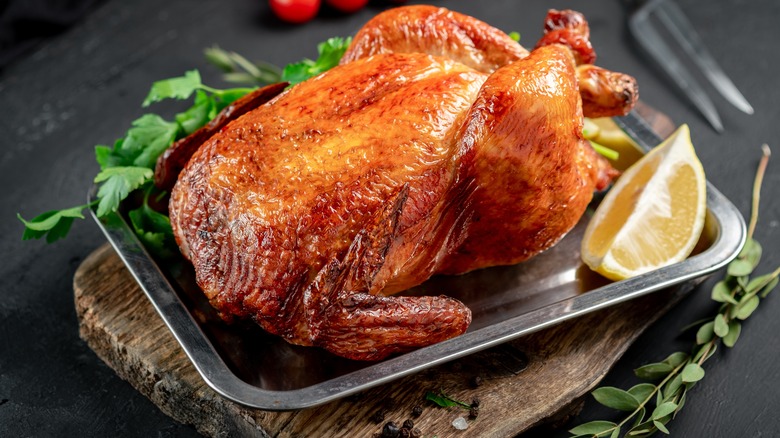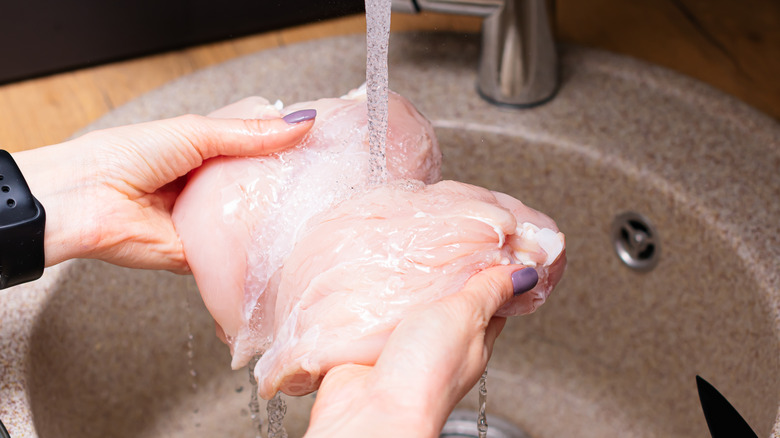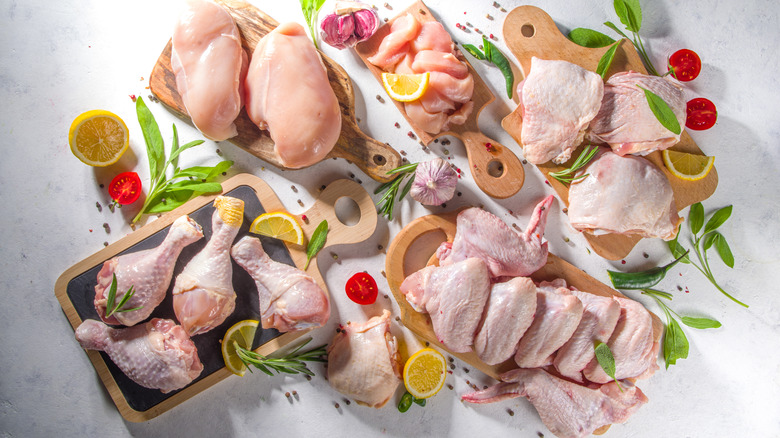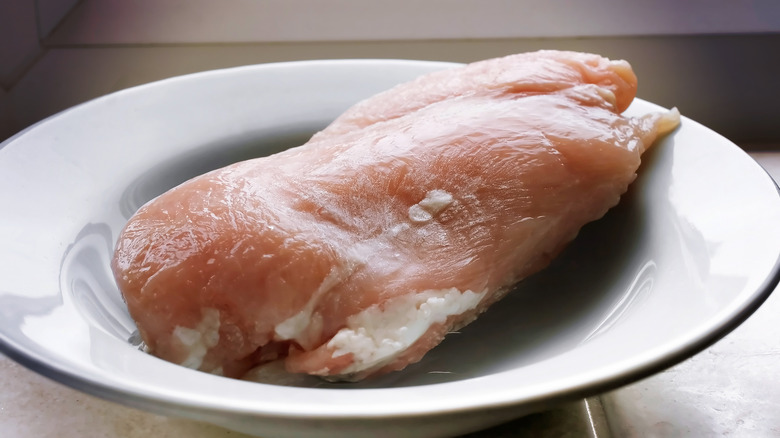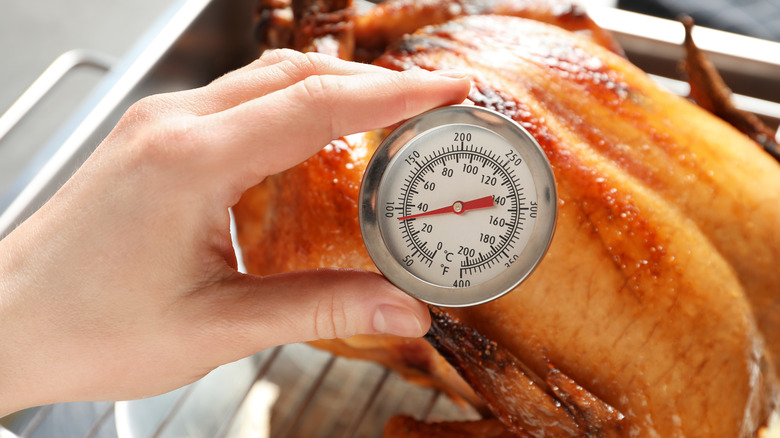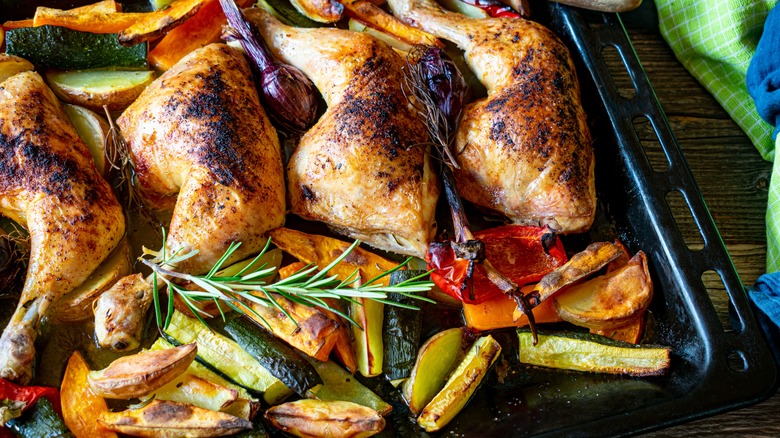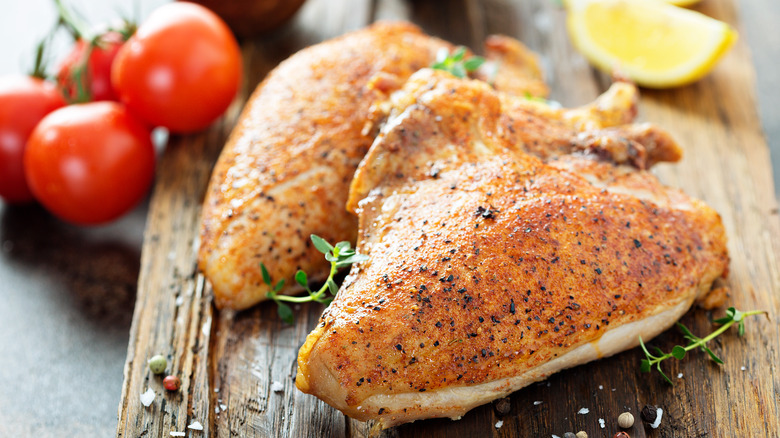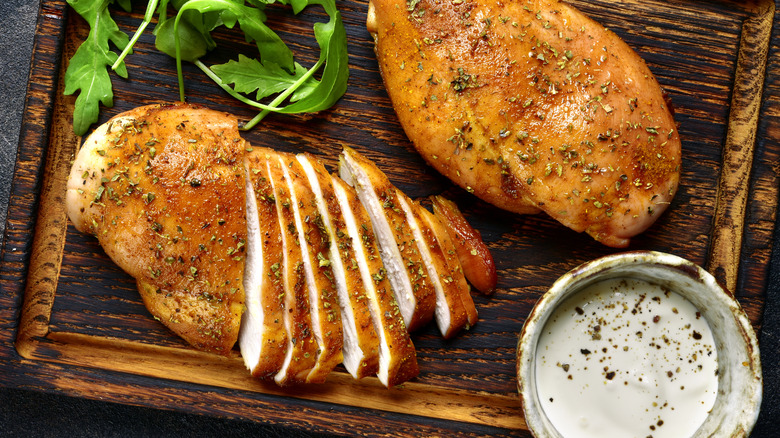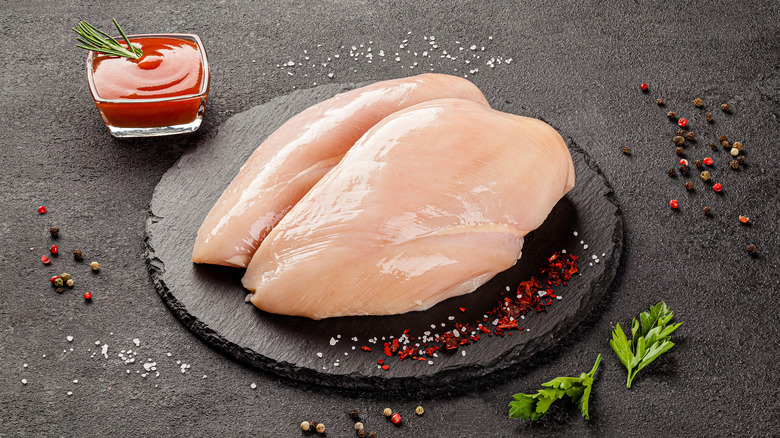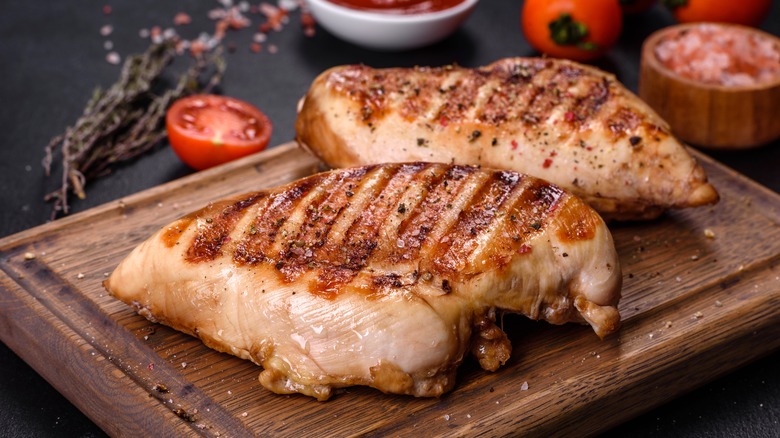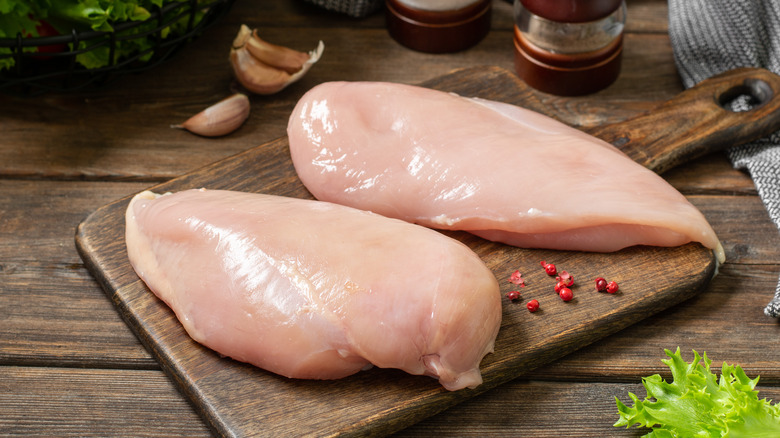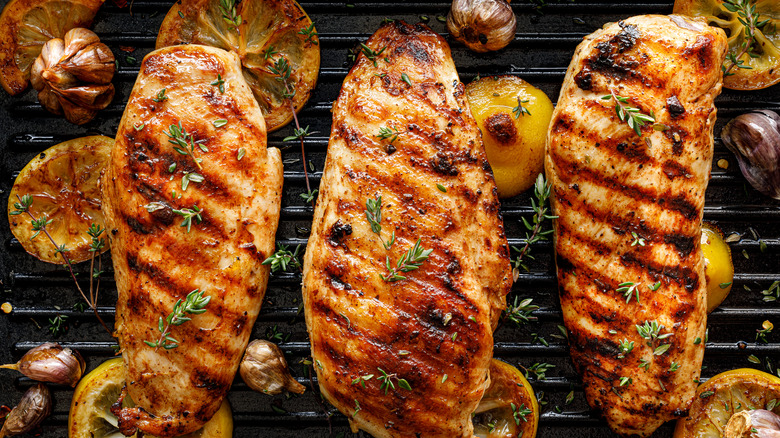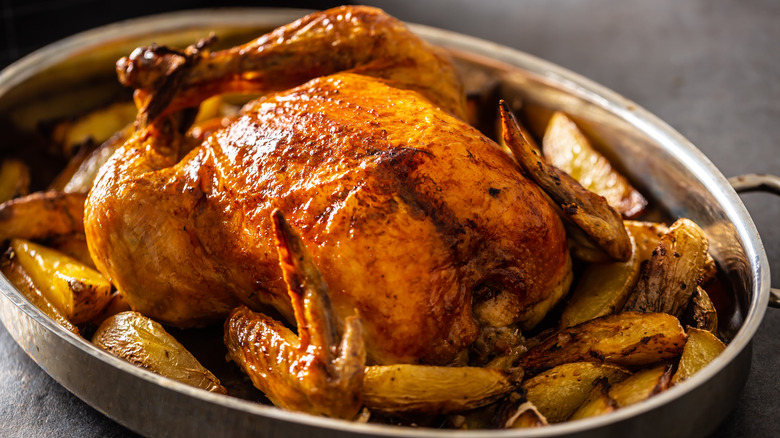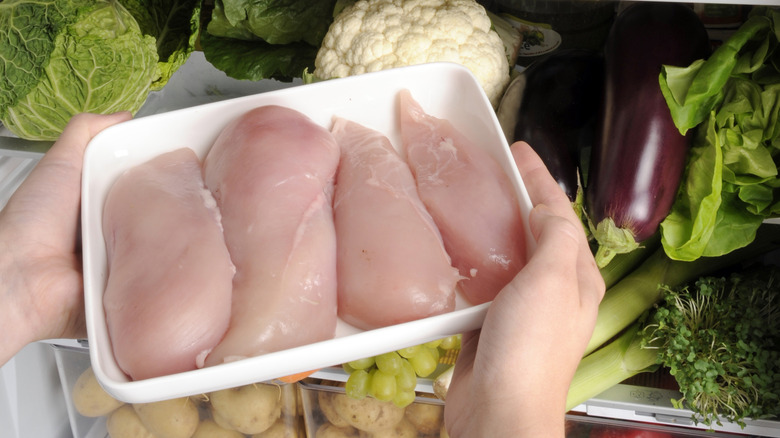Crucial Mistakes Everyone Makes When Cooking Chicken
Chicken is the most popular meat in the U.S., and indeed the planet, due to its versatility and affordability. It is the star of many delicious meals, from comforting home-cooked dishes to the sophistication of fine dining. As a home cook, mastering chicken is imperative in a meat-eating family, but there are many pitfalls when it comes to cooking this bird perfectly. In fact, improperly cooked poultry is infamous for causing food poisoning, meaning many amateur cooks are nervous about undercooking it and making someone ill. But that doesn't have to be you.
There are a few common mistakes that many of us make at home when cooking chicken, and by avoiding these issues, you can cook a succulent, delicious meal that will keep your whole family satisfied. Join us as we explore the crucial mistakes everyone makes when cooking chicken and learn how to become a poultry master in your own kitchen. From washing your chicken to over- or under-cooking it, we will help you avoid the pitfalls while finding the balance between safety and flavor, ensuring your meals are perfectly cooked every time.
Washing chicken before you cook it
With such a fuss being made about the potential dangers of raw chicken, many of us go to great lengths to reduce the chance of contamination within the kitchen. For some, this includes washing raw chicken before using it, supposedly to remove bacteria. Unfortunately, this is a myth and is actually dangerous. By splashing water over raw chicken, you are causing bacteria to spread across your kitchen, sometimes up to an arm's length away (via Safe Food.) This means that instead of a small chicken breast having bacteria on it, you are now faced with a large section of your kitchen being contaminated, and you're unlikely to even realize it.
Since contamination from chicken is a leading cause of food poisoning at home, it is important to reduce the spread of dangerous bacteria within your kitchen. Cooking chicken properly is the best way to kill bacteria, so keep it away from the sink and confined to a chopping board used solely for raw meat. Wash any utensils and boards immediately after cutting raw chicken, and wash your hands thoroughly with hot, soapy water once the chicken is safely in the oven or frying pan. This will further reduce the chance of food poisoning, rather than attempting to give the chicken a bath in the kitchen sink.
Cooking all cuts the same
When planning a chicken dish, one decision you need to make is which cut of meat to use. While it's unlikely that anyone would expect a breast of chicken to have the same cooking time as a whole bird, you may not realize that cooking times can vary dramatically between other cuts of chicken, particularly if the bone is left in. Since undercooked chicken can be dangerous and overcooked chicken is dry and tough, it's important to understand how long each cut needs to cook perfectly.
The most popular cut of chicken is the breast since it is lean and cooks quickly. A medium-sized chicken breast will take around 25 minutes to cook in the oven and still be juicy on the inside. Due to the lack of fat, the texture of chicken breast reduces significantly when overcooked, so it's important not to leave it in the oven too long.
Chicken thighs and drumsticks, on the other hand, have more fat and, therefore, more flavor. They take longer to cook but are more forgiving if you overshoot the cooking time by 10 minutes or so. Leaving the bones in while they cook will help keep them moist, but more time will be needed to cook them perfectly; 40 to 45 minutes for medium-sized chicken thighs or legs should result in delicious meat that falls off the bone.
Defrosting chicken at room temperature
When it comes to keeping chicken safe for more than a few days, freezing it is the best option. However, defrosting the meat properly then becomes a crucial step to ensure that food poisoning will not be an issue. Oftentimes we defrost food by removing it from the freezer and leaving it out all day, but unfortunately, with chicken, that is asking for trouble regarding food safety and the quality of the meat.
When meat defrosts, the outside naturally thaws the fastest since it is directly exposed to the air. This means if your chicken has been sitting on the counter for a few hours, the outside may seem defrosted, but the middle will still be frozen. If you cook it at this point, one of two things will happen — either the outside will be perfectly cooked and the inside will still be raw, or the inside will be cooked through and the outside will be dry and overdone. Either way, your dish will not be what you planned, and may even put those who eat it in danger of food poisoning.
Instead, the USDA recommends slowly thawing chicken in the refrigerator for at least a day to ensure it is completely thawed. This keeps the chicken out of the danger zone of 40 to 140 degrees Fahrenheit, reducing the risk of dangerous bacteria multiplying. This method, which will require a bit of forward planning, means your family can enjoy a chicken dish that has great texture and is safe to eat!
Not using a meat thermometer
Even the most enthusiastic home cooks may not have a meat thermometer as part of their kitchen setup, but it is a crucial tool if you want to get the cooking of your meat right every time. Without a thermometer, you are essentially guessing when the meat is done, and this means that you are likely to overcook, especially when it comes to poultry. Most people are so scared of undercooking chicken that they will overcook it just to be safe.
When chicken is cooked perfectly, it is moist and flavorful, and using a meat thermometer can help you gauge that sweet spot every time. The minimum safe internal temperature for chicken is 165 degrees Fahrenheit, and you must make sure the thickest part of the meat reaches this temperature. Unless you are a very experienced cook, it's unlikely you will get the temperature spot on every time without a thermometer, so buying one for yourself is a wise long-term purchase. It is a small price to pay to know your chicken will be safe and juicy every time, just make sure to keep it correctly calibrated.
Overcrowding the baking pan
If you want your chicken to cook evenly, it's important not to overcrowd the pan. Though it can be tempting to try to cram all of your meat, vegetables, and potatoes into one baking tray (especially if you've got the washing up to think about), spreading your dish over a couple of trays will give it breathing space and prevent some of your chicken being overcooked with other parts remaining raw.
Overlapping meat in a baking pan prevents steam from escaping as it should, meaning that moisture will build up, and the meat can end up stewing instead of roasting. If you're looking for a beautiful, crispy coating on your roast chicken, this is definitely something you want to avoid. If you don't have the space to cook everything across two or more baking pans, cook your chicken dish in batches. Keep the first batch hot until the next is done, or reheat it slightly before serving. Though it may take longer, it will be worth it to have perfectly cooked chicken that has been roasted exactly as you had planned.
Thinking the bone needs to be removed before cooking
When shopping for chicken, you might automatically reach for the boneless breasts, or decide to remove the bones yourself before cooking. Flavor-wise this could be a big mistake. Cooking chicken with the bone in enhances the flavor and results in a juicy cut of poultry, which is ultimately what we all want from a chicken dish. This is due to the fat surrounding the bone, which melts as it cooks and makes its way into the meat. The bone also helps conduct heat through the meat and make sure that the joint cooks evenly, avoiding the problem of some parts of the chicken being overcooked.
Once you have cooked your chicken with the bone in, you have another decision to make: Do you remove the bones before serving or allow everyone to tuck into them in a primal fashion, holding the bone and ripping the flesh off with their teeth? Ultimately, that decision is up to you, but you can guarantee that the meat will be deliciously juicy as a result of those fabulous bones.
Not marinating chicken breast
Chicken breast is a very popular cut of meat, particularly amongst those who are watching their fat intake, as it is lean. This lack of fat, however, can make it difficult to eat if it has been even slightly overcooked. Sometimes, even a perfectly cooked chicken breast can seem dry and tough compared to the fattier cuts. To avoid this problem, prep your chicken breast by marinating in the hours before cooking it.
The great thing about marinades is that there are so many to choose from, covering a wide range of cuisines and flavors. From citrus dressings to spicy sauces, almost anything goes when it comes to a marinade. All you need is a liquid that can soak into the meat and some strong flavors to add to it. Vegetable oils such as olive oil are commonly used in marinades, but other bases, such as yogurt, are also effective and often used along with spices. Adding an acid to the marinade does more than simply add moisture and flavor; the acid begins to break down the protein in the meat, making it more tender and, therefore, more enjoyable to eat. The step of marinating your chicken is well worth the extra effort, turning a plain lean chicken breast into a succulent and delicious meal.
Cooking large chicken breasts whole
When cooking any size of chicken breast whole, it can be quite a challenge to get a perfect golden crust on the outside while the middle is succulent and juicy. Often, the outside ends up overcooked and tough, making for an unpleasant eating experience. If the breast is a particularly large one, even a very skilled chef may struggle to cook it perfectly. But there are a few tips that will result in perfectly cooked meat with just a few extra minutes of preparation time.
Slicing your chicken breast horizontally through the thickness of the meat will give you two, much thinner breasts to cook instead. This allows for much more even cooking, but still enables you to serve the meat as one piece. A similar effect can be achieved by butterflying the breast, which involves cutting most of the way through and then opening out the meat into one large, flat plank.
If neither of these options suits you, you can tenderize the chicken breast by pounding it with a mallet. This will flatten the meat out while allowing you to take out your stress from the day, but some of the texture of the chicken will be lost in the process. However you choose to alter your chicken breast, bear in mind that the cooking time will be significantly shorter than for a whole breast as is, so be sure to adjust your recipe accordingly.
Overcooking the chicken
As mentioned above, in our quest to avoid undercooking our chicken and prevent food poisoning, many home cooks err on the side of caution and significantly overcook the meat instead. If overcooked chicken is a frequent occurrence in your house, you may wish to consider a cut of meat that can handle a longer cooking time. Chicken breast dries out at the slightest extension of time in the oven, so try your culinary hand with the darker meat to reduce the chance of error. If you have a slow cooker, make use of it to ensure your chicken dishes are never dry again. Marinating the meat in advance, then slow cooking the thighs for around four hours, will create a mouthwatering chicken dish that will fall off the bone.
No matter what cooking method you use, letting your chicken rest afterward is crucial to serving a dish that doesn't taste or feel dried out. This step allows the juices to redistribute throughout the meat, making sure each bite is flavorful and moist.
Not drying off the chicken before cooking
Thanks to this article, you will no longer make the mistake of washing your chicken before cooking, but it may still have moisture around the outside. Chicken can often be covered in water and fluids from the packaging, and it is crucial to get rid of this before you start cooking.
When cooking your chicken, the goal should be to get the outside perfectly golden, and moisture is the enemy in this case. You want your pan or oven to start browning the meat right away instead of spending time evaporating water off first. To speed up the process of creating a crispy golden exterior, pat the outside of the chicken dry with a few paper towels before you prepare it for cooking. If you need to remove the skin, pat it dry after you have taken it off. This simple preparation step that only takes a few seconds will ensure your chicken starts to brown the moment the heat hits it, resulting in a dish that looks fantastic and tastes even better.
Underseasoning the chicken
If you want to cook a truly fantastic chicken dish, the key is to season it really well. This doesn't simply mean a pinch of salt and a twist of black pepper, but infusing the meat with flavors from many different sources. As a lean protein, chicken lacks the flavorsome fat of many other meats, so it needs plenty of punchy flavors to prevent it from tasting bland. This particularly applies to the leanest cut, the breast.
There are a few traditional chicken seasonings that are classics for good reason. Garlic and dried herbs complement the meat perfectly, with oregano, rosemary, and thyme all working well. Rubbing a garlic-and-herb-infused butter across the whole chicken or breast before cooking will infuse the meat with a delicious assortment of flavors as it cooks. Roasted chicken with lemon is another favorite, with the lemon either added to a marinade or tucked into the cavity of the whole bird before roasting. The bright flavor will give a freshness to the poultry, and the same citrus kick can be added to side dishes such as roasted vegetables.
If you want something with more kick, standard chili flavors take the flavor to a new level. Choose a heat index to suit your dinner companions, from mild jalapeños to fiery habaneros. Consider serving a creamy dip alongside the spicy chicken for balance and to ensure the spice doesn't overwhelm the meal.
Pouring away the chicken fat after cooking
If you cook any part of a chicken other than the breast, you are guaranteed to have some fat that melts out during cooking and ends up in the bottom of the baking tray. There are so many things you can do with this rendered chicken fat — also known as schmaltz — but there is one thing you must not do: pour it away. This golden elixir is packed with wonderful umami flavor, and it would be a culinary sin to discard it.
You can use schmaltz immediately to add flavor to any side dish you're cooking along with the chicken, such as potatoes or vegetables. In fact, roasting a whole chicken on top of potatoes is a great way to incorporate the fat into the roast potatoes without any extra effort. If you don't have any use for the fat at the time, you can cool it and refrigerate it until you're ready to use it. Rendered chicken fat can be added to gravy and sauces for increased richness or drizzled over vegetables in place of olive oil. So the next time you have a beautiful pool of schmaltzy goodness at the bottom of your tray, don't waste it — save it instead to enhance future dishes with its rich, savory flavor.
Cooking chicken straight from the fridge
One last common mistake that home cooks make when preparing poultry is cooking raw chicken straight from the fridge. Thinking ahead and taking the chicken out of the fridge in advance will increase the chance of it being perfectly and evenly cooked. Since the center of the chicken will take longer to cook if it has stayed cold in the fridge, you're likely to have the issue of the exterior being cooked while the middle is still raw.
You shouldn't, however, leave your chicken sitting out at room temperature for a long time, as bacteria can build up quickly. Taking it out of the fridge about 15 minutes before cooking should be enough time to bring the meat up to a slightly warmer temperature without compromising its safety. It means the meat will cook evenly and result in a perfectly crisp outside with a succulent center. You can use the time it takes to come to room temperature to season the meat and prepare it for cooking.

